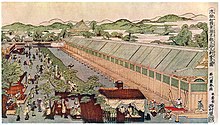
Back اتاجاوا تويوهارو ARZ Utagawa Toyoharu Catalan Utagawa Toyoharu German Utagawa Toyoharu Spanish اوتاگاوا تویوهارو Persian Utagawa Toyoharu French Toyoharu Utagawa ID 歌川豊春 Japanese 우타가와 도요하루 Korean Utagawa Toyoharu Portuguese
Utagawa Toyoharu (歌川 豊春, c. 1735 – 1814) was a Japanese artist in the ukiyo-e genre, known as the founder of the Utagawa school and for his uki-e pictures that incorporated Western-style geometrical perspective to create a sense of depth.

Born in Toyooka in Tajima Province,[1] Toyoharu first studied art in Kyoto, then in Edo (modern Tokyo), where from 1768 he began to produce designs for ukiyo-e woodblock prints. He soon became known for his uki-e "floating pictures" of landscapes and famous sites, as well as copies of Western and Chinese perspective prints. Though his were not the first perspective prints in ukiyo-e, they were the first to appear as full-colour nishiki-e, and they demonstrate a much greater mastery of perspective techniques than the works of his predecessors. Toyoharu was the first to make the landscape a subject of ukiyo-e art, rather than just a background to figures and events. By the 1780s he had turned primarily to painting. The Utagawa school of art grew to dominate ukiyo-e in the 19th century with artists such as Utamaro, Hiroshige, and Kuniyoshi.


- ^ Marks, Andreas (2010). Japanese woodblock prints Artists, Publishers and Masterworks 1680-1900. Tuttle Publishing. ISBN 978-4-8053-1055-7.
© MMXXIII Rich X Search. We shall prevail. All rights reserved. Rich X Search